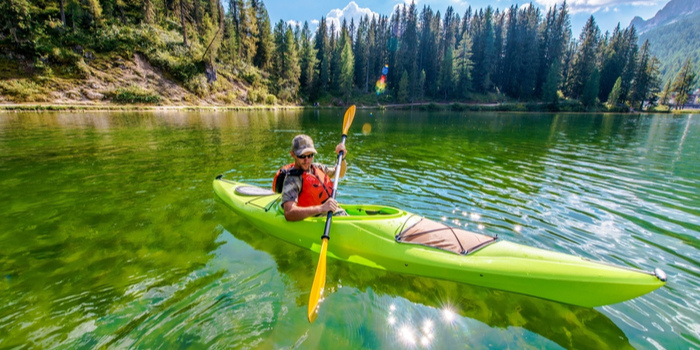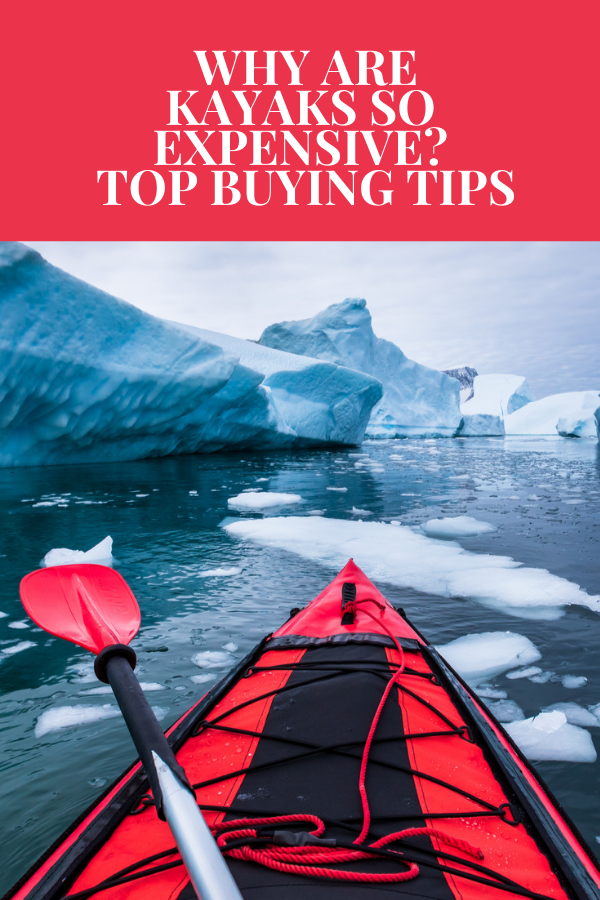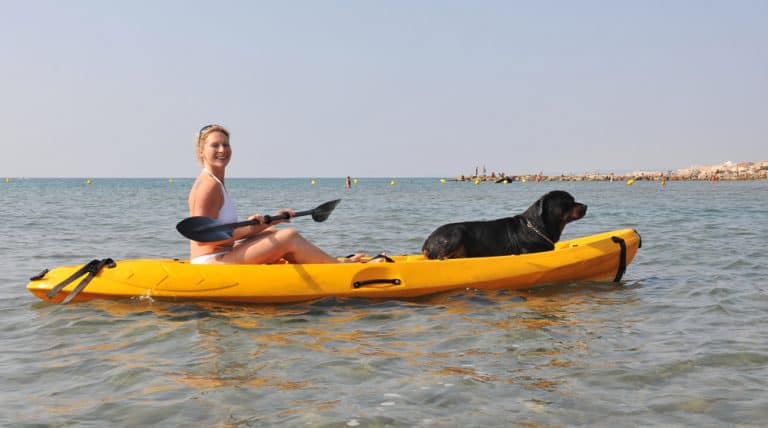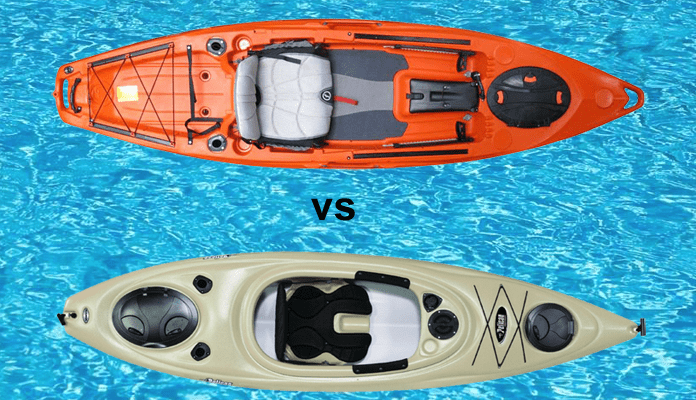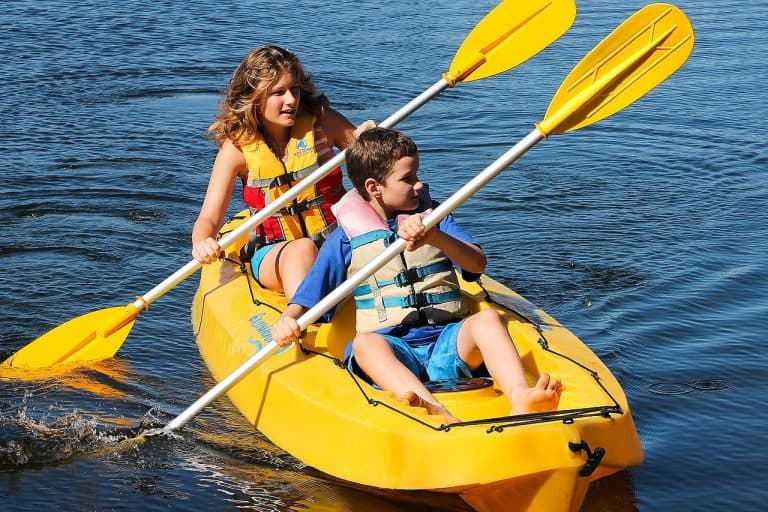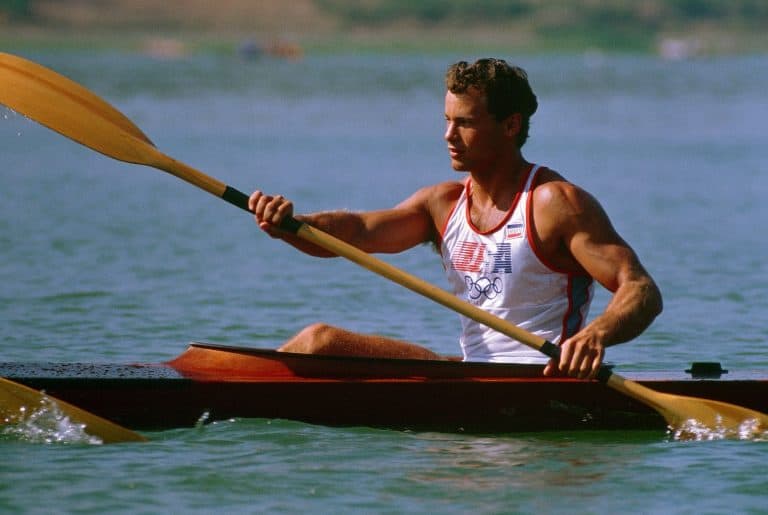Unless you have an unlimited budget and you are in the market for one of the most expensive kayaks, you may be shocked by the price tags on kayaks these days. So why are kayaks so expensive?
The good news is that there are still plenty of options for affordable recreational kayaks out there. You don’t necessarily have to sacrifice massively when it comes to quality to get one either.
That said, it is not uncommon to find fishing kayaks and those for other applications going for four-digit prices. What is driving up the price of kayaks and are they really worth the high cost?
In this guide, we will explore that exact question and we will also provide kayak buying tips to help you find a model that fits with your budget. So let’s get started!
Photo by Nikolay Kovalenko on Unsplash
Why Are Kayaks So Expensive?
To be honest, not all of them are! There are plenty of sit-on-top kayaks under $300 out there if you aren’t ready to spend a lot to get on the water more frequently.
For beginners, it can be best to start by investing in a cheaper kayak while you are still investigating whether or not you really like this sport (of course we hope you do!).
As you gain experience, you may want to upgrade to a kayak that is better for the exact type of paddling you prefer. So here are a few reasons why higher-end kayaks get so expensive.
They Are Made of More Than Just Plastic
Photo by Bettye Maki on Flickr
Many of the most affordable kayaks under $1000 are indeed manufactured using polyethylene plastic, which is one of the most abundantly produced plastics in the world.
Kayaks include more than just that polyethylene material, however. They have cushioned seats, bungee rigging, mesh netting, foam bulkheads, and a variety of other elements.
Even though the materials used in some kayaks may not be crazy expensive, those materials must be shaped and formed once they arrive at the manufacturer’s production facility.
Many kayak manufacturers use a technique called rotomolding (rotational molding) to form their kayaks. This process involves heating up the polyethylene material and then pouring it into a mold or cast so that it cools to the exact shape you are looking for.
This is a delicate process and it requires an incredibly accurate mold that must be checked and double-checked between molds. This adds a significant amount of time to the manufacturing process and contributes to the higher price of kayaks that require more intricate molds.
In addition, many expensive kayaks use materials like fiberglass or carbon fiber instead of polyethylene. These materials are more expensive to source and more delicate to mold into the desired shape.
They Include An Abundance of Features
Photo by Jenni232323 on Flickr
As you compare and contrast kayaks, you will find that the most expensive models are packed with added features. The cheaper models, on the other hand, can appear very basic even if they are all that is needed for recreational paddling.
This is one of the reasons why the best ocean fishing kayaks are often among the most expensive selections on the market. They include features like pedal-driven systems, fishing rod holders, removable tackle boxes, cup holders, and much more.
The good news about this factor is that you get to choose exactly which features you need when you are selecting a kayak. So you can save a little bit of money by prioritizing ”˜must-have’ features over ”˜would-be-nice-to-have’ features.
They Come With Accessories
Photo by Let Ideas Compete on Flickr
This is not true of all kayaks, but many of them come with a bunch of extra accessories. If you are brand new to kayaking, it can be useful to purchase a kayak that comes with everything you need to get started.
Some examples of these accessories include a paddle, seat, dry bag, waterproof phone case, high-output hand pump, and storage bag (the last two are pertinent to only the best inflatable kayaks, of course).
While this can be extremely useful for beginners, it will drive up the final price of the kayak. So if you already have most of the essential kayaking gear you need, there is no reason to purchase a kayak that comes with a bunch of unnecessary accessories.
They Are Made Far Away
Photo by Arvid Hoidahl on Unsplash
Historically, some of the earliest kayaks were used by fishing cultures that lived near oceans or large lakes. Today, many kayak manufacturers are still based close to where their kayaks will eventually live out their happy days on the water.
For those of you that live inland, that can mean paying higher shipping costs to get a high-quality kayak to your doorstep. Even if you buy a kayak in a store near you, it probably had to be shipped from somewhere a ways off.
Any product that has to travel a longer distance to get to you is usually going to cost more than a product that is produced locally. If you live close to lots of lakes or right on the ocean, you may find better deals on kayaks than those of you in more landlocked locations.
This is also true of the kayak resale market. Because there will often be a larger number of used kayaks for sale in places where the paddling culture is more vibrant, new kayakers will be able to break into the sport for less than those of you living where paddling isn’t quite as popular.
They Are Durable
Photo by taiga_sg on Flickr
We wish we could say that this true for all kayaks out there. Unfortunately, certain kayaks are more durable and will last longer than others.
If you are shopping for expensive kayaks, however, you should reasonably expect them to last for 15 to 20 years. Cheaper kayaks can wear out or break within 3-5 years, on the other hand.
Some relatively simple math brings us to the fact that you could buy four cheap kayaks in the same amount of time you would use a single kayak of higher quality. In the end, you may wind up saving money in the long term by buying a more expensive kayak.
This is especially true if you properly maintain your kayak using the tips from our article on Kayak Maintenance 101!
What Is The Most Expensive Type of Kayak?
Photo by Rohith Goura on Unsplash
Kayak prices also vary depending on their type. By type, in this instance, we are referring to kayaks for recreation, touring, fishing, whitewater, surfing, and other applications.
When we take averages into account, the most expensive type of kayak is made for deep-sea kayaking. It is not too hard to imagine why because this environment is arguably one of the most dangerous and variable that the kayaker could enter.
The best touring kayaks for deep-sea applications need to handle large waves and heavy winds. Most of them are equipped with pedal-controlled rudders and skegs to help with tracking, which require a lot more moving parts than you will find on other kayaks.
Aside from deep sea touring kayaks, pedal-driven fishing kayaks are also some of the most expensive types of kayaks. Their higher cost is largely the result of the pedal-drive technology they incorporate and the other fishing-specific features with which they are outfitted.
Are Expensive Kayaks Worth The High Cost?
Photo by Veronique Estie on Unsplash
Yes…for the right kayaker.
In our opinion, paying more than $1,000 for an expensive kayak is really only worth it if you are an intermediate or experienced paddler. You need to know what you are looking for and have the requisite skills to handle these fancier kayak models.
For beginners, we wouldn’t recommend spending a bunch of money on a new kayak before you really know if you are going to like it. In many cases, it can also be useful to rent several different types of kayaks to gain experience and see which you like best.
Spend a year or two trying out different types of kayaks and honing your kayaking skills before you opt for a more expensive kayak.
Top Buying Tips For Kayaks
Photo by Bradley Brister on Unsplash
Every paddler will have different personal preferences when choosing a new kayak. So keep in mind that you can prioritize these factors as you see fit when you begin your search to add a new kayak to your quiver.
Kayak Type by Activity
Fortunately, most kayaks are labeled according to the activity they are made for. So your first choice will be to decide whether you will spend most of your paddling time fishing, running whitewater rapids, covering long distances, or just hanging out for some recreation time.
Keep in mind that there are great crossover kayaks out there that will allow you to enjoy multiple kayaking activities without having to switch kayaks. It will be beneficial to you, however, to choose a kayak that is specifically designed for your primary activity.
Sit on Top or Sit Inside?
Photo by Inflatable Kayaks on Flickr
While you won’t find too many sit-on-top whitewater kayaks out there, you will often find both sit-on-top and sit inside kayaks for the other main kayaking activities. So deciding whether a sit-on-top or sit inside is better for you is the next step to narrowing down your choices.
Many guide companies used sit-on-top kayaks for beginners because they are easier to learn on and easier to turn over if you capsize. They are also easier to climb back into than even the best sit-in kayaks.
Sit-on-top kayaks are also the best choice for fishing applications because they tend to be more open and easier to maneuver in tight spots. The best kayaks for stand-up fishing always feature sit-on-top cockpits with flat, stable bottoms, for example.
Sit inside kayaks are the preference of many long-distance kayakers because they can incorporate one of the best kayak spray skirts when the weather takes a turn for the worse. This keeps your lower half warm and completely dry and should always be part of any cold weather kayak gear list.
Even without a spray skirt, sit inside kayaks tend to keep the paddler drier in windy and wavy conditions. This is why many ocean-based kayaking companies prefer to use sit inside kayaks over sit-on-tops.
In summary, if you are a beginner and plan to paddle mostly on calm lakes or slow-moving rivers, go for a sit-on-top kayak. If you are an intermediate or advanced paddler looking for a kayak that can handle more adverse weather conditions, prioritize sit inside kayaks.
Hull Shape and Chine
Photo by Woodleigh School on Flickr
There are four main hull shapes on kayaks. They are:
- Flat
- Rounded
- V-Shaped
- Pontoon
Most recreational kayaks have flat hulls because they are very stable and easily maneuverable. This is the best hull shape for beginner kayaks because speed is less of a priority.
Kayaks with rounded hulls are more efficient through the water and have less drag than kayaks with flat hulls. This allows the paddler to achieve higher top speeds while still providing decent maneuverability and great secondary stability.
Kayaks with V-shaped hulls are the best choice for long-distance paddling and ocean touring. They cut through the water seamlessly and require the least effort to paddle in a straight line, but they don’t turn and maneuver as quickly as kayaks with other hull shapes.
Most river fishing kayaks boast pontoon hulls because they provide the highest degree of stability when your kayak is standing still in the water. Even though you have to compromise on top speed, kayaks with pontoon hulls provide a great compromise between the primary stability of a flat hull and the secondary stability of a rounded hull.
In addition, kayaks also have either soft or hard chines. Chine describes the manner in which the manufacturer blends the bottom (hull) of the kayak into the sides (gunwales).
Kayaks with a rounder (softer) chine provide more secondary stability when the kayak tips on its side. Kayaks with more angled (harder) chine offer better primary stability when the kayak is sitting flat in the water or not moving.
Weight Limit
Photo by Jim Flanagan on Flickr
All of the best kayak brands actively advertise the weight limits for their kayaks. Only a few, however, will specify the maximum weight capacity from the usable weight capacity of their kayak models.
What do we mean by this?
To put it simply, the performance of most kayaks begins to suffer when they are loaded down past roughly 70 to 80 percent of their advertised maximum weight capacity.
A kayak’s true usable weight capacity, then, is typically slightly lower than its advertised capacity. To give you a quick example, let’s consider a high-end fishing kayak with an advertised capacity of 600 pounds.
600 x 0.7 = 420 pounds and 600 x 0.8 = 480 pounds
So even though the manufacturer says it can handle 600 pounds of the combined paddler and gear weight, you really only want to load your kayak down with 420 to 480 pounds if you want it to perform up to its standard.
Length and Width
Photo by Frank Busch on Flickr
A kayak’s dimensions will dictate your ability to handle it well. Longer and narrower kayaks generally go faster and track straighter while shorter and wider kayaks tend to be more stable and easier to maneuver quickly.
This is why the best whitewater kayaks tend to be quite short and the long-distance touring kayaks can be upwards of 17 feet long. Most recreational kayaks fall between eight and 13 feet in length.
The perfect kayak length for you will depend on your primary activity and also your height. Paddlers over six feet tall, for example, will probably want to choose a kayak with a minimum length of 12 feet so that the cockpit provides plenty of room to sit comfortably (without having your knees bent up into your chest).
When it comes to width, wider kayaks offer more stability and narrower kayaks track straighter and offer less drag. This is why narrower kayaks are used for kayak racing and wider kayaks are used for applications like kayak fishing and whitewater kayaking.
Final Thoughts
Photo by Scott Nothwehr on Unsplash
There are two main schools of thought when it comes to buying kayaks. You can either look for an affordable option that will meet most of your needs or prioritize a kayak that suits all of them.
If you choose the latter approach, you will probably be shopping for more kayaks with slightly higher price tags. The benefit of that is that you probably won’t have to shop for another kayak again for 15 to 20 years if you make a quality choice.
Speaking of making that quality choice, we hope you found the top buying tips for kayaks useful in this guide. We also hope you have learned more about how kayaks are priced and whether or not they are worth the cost.
As always, we wish you the happiest and healthiest of kayak adventures during the upcoming season. Drop us a quick comment below and let us know where you will be paddling in the next few months!

